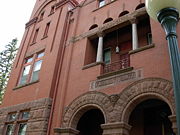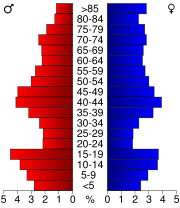
Faribault County, Minnesota
Encyclopedia


Census
A census is the procedure of systematically acquiring and recording information about the members of a given population. It is a regularly occurring and official count of a particular population. The term is used mostly in connection with national population and housing censuses; other common...
of 2000, there were 16,181 people, 6,652 households, and 4,476 families residing in the county. The population density
Population density
Population density is a measurement of population per unit area or unit volume. It is frequently applied to living organisms, and particularly to humans...
was 23 people per square mile (9/km²). There were 7,247 housing units at an average density of 10 per square mile (4/km²). The racial makeup of the county was 97.11% White
Race (United States Census)
Race and ethnicity in the United States Census, as defined by the Federal Office of Management and Budget and the United States Census Bureau, are self-identification data items in which residents choose the race or races with which they most closely identify, and indicate whether or not they are...
, 0.24% Black
Race (United States Census)
Race and ethnicity in the United States Census, as defined by the Federal Office of Management and Budget and the United States Census Bureau, are self-identification data items in which residents choose the race or races with which they most closely identify, and indicate whether or not they are...
or African American
Race (United States Census)
Race and ethnicity in the United States Census, as defined by the Federal Office of Management and Budget and the United States Census Bureau, are self-identification data items in which residents choose the race or races with which they most closely identify, and indicate whether or not they are...
, 0.19% Native American
Race (United States Census)
Race and ethnicity in the United States Census, as defined by the Federal Office of Management and Budget and the United States Census Bureau, are self-identification data items in which residents choose the race or races with which they most closely identify, and indicate whether or not they are...
, 0.36% Asian
Race (United States Census)
Race and ethnicity in the United States Census, as defined by the Federal Office of Management and Budget and the United States Census Bureau, are self-identification data items in which residents choose the race or races with which they most closely identify, and indicate whether or not they are...
, 0.04% Pacific Islander
Race (United States Census)
Race and ethnicity in the United States Census, as defined by the Federal Office of Management and Budget and the United States Census Bureau, are self-identification data items in which residents choose the race or races with which they most closely identify, and indicate whether or not they are...
, 1.36% from other races
Race (United States Census)
Race and ethnicity in the United States Census, as defined by the Federal Office of Management and Budget and the United States Census Bureau, are self-identification data items in which residents choose the race or races with which they most closely identify, and indicate whether or not they are...
, and 0.69% from two or more races. 3.50% of the population were Hispanic
Race (United States Census)
Race and ethnicity in the United States Census, as defined by the Federal Office of Management and Budget and the United States Census Bureau, are self-identification data items in which residents choose the race or races with which they most closely identify, and indicate whether or not they are...
or Latino
Race (United States Census)
Race and ethnicity in the United States Census, as defined by the Federal Office of Management and Budget and the United States Census Bureau, are self-identification data items in which residents choose the race or races with which they most closely identify, and indicate whether or not they are...
of any race. 45.5% were of German, 21.2% Norwegian and 5.1% Irish
Irish people
The Irish people are an ethnic group who originate in Ireland, an island in northwestern Europe. Ireland has been populated for around 9,000 years , with the Irish people's earliest ancestors recorded having legends of being descended from groups such as the Nemedians, Fomorians, Fir Bolg, Tuatha...
ancestry according to Census 2000.
There were 6,652 households out of which 28.50% had children under the age of 18 living with them, 57.80% were married couples
Marriage
Marriage is a social union or legal contract between people that creates kinship. It is an institution in which interpersonal relationships, usually intimate and sexual, are acknowledged in a variety of ways, depending on the culture or subculture in which it is found...
living together, 6.10% had a female householder with no husband present, and 32.70% were non-families. 29.70% of all households were made up of individuals and 16.80% had someone living alone who was 65 years of age or older. The average household size was 2.36 and the average family size was 2.93.
In the county the population was spread out with 24.40% under the age of 18, 6.70% from 18 to 24, 23.20% from 25 to 44, 23.50% from 45 to 64, and 22.20% who were 65 years of age or older. The median age was 42 years. For every 100 females there were 97.20 males. For every 100 females age 18 and over, there were 92.50 males.
The median income for a household in the county was $34,440, and the median income for a family was $41,793. Males had a median income of $28,990 versus $20,224 for females. The per capita income
Per capita income
Per capita income or income per person is a measure of mean income within an economic aggregate, such as a country or city. It is calculated by taking a measure of all sources of income in the aggregate and dividing it by the total population...
for the county was $17,193. About 5.50% of families and 8.60% of the population were below the poverty line, including 9.40% of those under age 18 and 10.20% of those age 65 or over.
Cities and towns
| Cities | Townships | Unincorporated | |
|---|---|---|---|
|
Clark Township, Faribault County, Minnesota Clark Township is a township in Faribault County, Minnesota, United States. The population was 459 at the 2000 census.-Geography:According to the United States Census Bureau, the township has a total area of , all of it land.-Demographics:... Foster Township, Faribault County, Minnesota Foster Township is a township in Faribault County, Minnesota, United States. The population was 314 at the 2000 census.-Geography:According to the United States Census Bureau, the township has a total area of , of which, of it is land and of it is water.-Demographics:As of the census of 2000,... |
|
Clayton, Minnesota Clayton was the name of a town in section 4 of Seely Township, Faribault County, Minnesota, United States.-History:Clayton had a post office from 1860 until 1899. The town failed to develop as hoped, and the population dwindled and the buildings were moved to neighboring Bricelyn, until in 1977... Homedahl, Minnesota Homedahl is an abandoned townsite in sections 29 and 30 of Seely Township in Faribault County, Minnesota, United States.-History:The town was originally settled by the Osul Haaland family, Norwegian immigrants. Rasmus O... Huntley, Minnesota Huntley is an unincorporated community in Faribault County, Minnesota, United States. Huntley is southwest of Winnebago. Huntley has a post office with ZIP code 56047.... |
† A minor part of Minnesota Lake also extends into Blue Earth County
Blue Earth County, Minnesota
Blue Earth County is a county located in the U.S. state of Minnesota. As of 2010, the population was 64,013. Its county seat is Mankato.Blue Earth County is part of the Mankato–North Mankato Metropolitan Statistical Area.-Geography:...
.
See also
- National Register of Historic Places listings in Faribault CountyNational Register of Historic Places listings in Faribault County, MinnesotaThis is a list of the National Register of Historic Places listings in Faribault County, Minnesota. It is intended to be a complete list of the properties and districts on the National Register of Historic Places in Faribault County, Minnesota, United States...
, Minnesota

